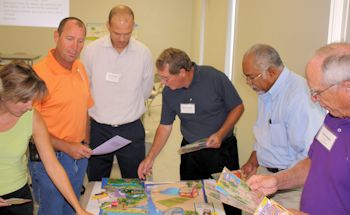Reprinted From the Carteret County News-Times
CEDAR POINT – Nearly 40 town officials gathered around three long tables last week to play a game.
But it was a game with a serious message – how to reduce polluting stormwater from running off into coastal waters.
Supporter Spotlight
The “watershed game” was part of leadership training in a course on coastal growth strategies held at Western Park Community Building in this small community in Carteret County.
Set up like a classroom educational game, the adults figured out ways to reduce stormwater runoff in area waters. Based on a variety of land uses, such as forest, agricultural, commercial or residential areas, they were able to arrange various initiatives to reduce the amount of pollutants in their fictional waters.
The game was designed to apply the strategies that the town officials had heard from lectures during the seminar.
Buddy Guthrie, the mayor of Cedar Point, gave the welcoming address and said coastal growth is a major issue in the area, including the connection between land use and water quality and how to incorporate environmentally friendly low-impact development, or LID, techniques. LID is an innovative approach to stormwater control that attempts to mimic land’s natural ability to absorb runoff from rain.
 A team at the seminar plays a “watershed game” as a way of finding new approaches to control stormwater runoff. |
They were among the main topics at the daylong seminar, which was sponsored by the N.C. Coastal Federation. Fourteen speakers focused on how to retrofit existing development or build new ones that are better for the environment in how they control runoff.
Supporter Spotlight
Lauren Kolodij, the federation’s deputy director, and Gloria Putnam, the coastal resources and community specialist with North Carolina Sea Grant, ran the day’s event. Both women stressed the importance of diverting or filtering polluted stormwater runoff and how it affects area waters.
Whitney Jenkins delivered the first lecture of the morning. She’s with the coastal training program the state’s National Estuarine Research Reserve. She said there is increased stormwater runoff as communities develop and more impervious surfaces – roads, parking lots and the like – are built. Such hard surfaces don’t allow runoff to soak into the ground. They instead channel stormwater to the nearest water body.
Jenkins focused on local watersheds, such as White Oak and Neuse rivers. She spoke about the sources of pollution and noted that nutrients, bacteria and sediment are the main pollutants of concern.
A formerly with the N.C. Division of Water Quality, Putnam displayed current charts showing state waters that are experiencing problems. She talked about the various state water classifications, standards and assessments.
Chris Seaberg, Cedar Point’s administrator, explained that his town and neighboring Cape Carteret collaborated on an easy-to-use manual that encourages developers and homeowners to use the LID techniques to control stormwater from new and existing developments.
The two towns approved the manual in October, Seaberg noted, after spending more than a year working on it with a technical review team made up of 15 local people from a variety of professions.
The guide, he said, show how small towns can encourage LID as a workable strategies, such as rain gardens and cisterns, to reduce the effects of stormwater runoff. A wide range of communities, organizations, agencies and developers are becoming increasingly more interested in LID.
“The secret to protecting and restoring water quality is to reduce the flow of stormwater coming off the land,” Seaberg said.
One notable LID feature in Cedar Point is the large rain garden beside town hall that filters stormwater from the surrounding 11 acres, even though it’s only about a third of an acre in size.
The project was made possible through state and federal grants, which also paid for a number of LID projects in Cedar Point. Their goal is to reduce stormwater runoff that is closing shellfish waters in the nearby White Oak River.
Other presentations throughout the day described how rainwater can be collected and reused and LID projects in Pender County.
Those attending seminar seemed to learn something new and many asked questions throughout the day. The seminar also included visits to several LID sites.







